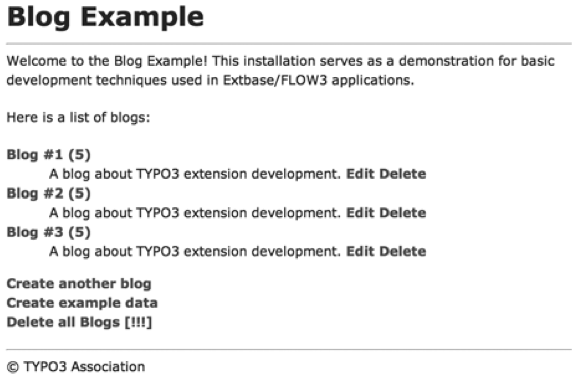Attention
TYPO3 v9 has reached its end-of-life September 30th, 2021 and is not maintained by the community anymore. Looking for a stable version? Use the version switch on the top left.
You can order Extended Long Term Support (ELTS) here: TYPO3 ELTS.
Calling the extension¶
When a user opens the web page containing our blog in their browser,
this request (Request) will be forwarded to the remote TYPO3 Server. Then
TYPO3 starts the processing of this request straight away.
A request generally contains the identifier of the page
(the so called page slug) that should be generated (e. g. /blog). Using
this page identifier, TYPO3 searches all relevant content elements on the
specific page and converts these to HTML code one after another. While
processing this page request, TYPO3 discovers the content element for our
example extension, the so called plugin. This plugin should display a list
of all blogs. Each with an individual title, a short description and the
amount of all enclosed posts. In figure 3-4 you can see the output of the
plugin in the frontend. This output is embedded within the greater overview
of the page.

Figure 3-4: Output of the plugin of our example extension¶
The process of eradication is first forwarded to the dispatcher
of Extbase by TYPO3.
Before the execution is handed to our own controller code, the
dispatcher and the parent ActionController complete several
preliminary tasks before they hand the further processing on
to the according position within the code of our blog example:
It interprets the incoming request and bundles all relevant information into a
Requestobject.It prepares the
Responseobject as a container for the result of the request.It loads the configuration of our extension from the different sources and makes it available.
It determines whether or not the request was manipulated in an illegal manner and when this is the case deflects it (e.g. in of case maliciously added form input field).
It sets up the persistence layer which performs the persisting of new or changed objects.
It prepares the cache in which the content is stored for faster reuse.
It instantiates and configures the controller of our extension which controls further processing within the extension.
When these preparations are fulfilled, we
are able to travel to the first stop of our destination: the controller. In
our example all further processing is assigned to the
BlogController. A reference to the request and the
response is handed over.
The class BlogController can be found in the
file
EXT:blog_example/Classes/Controller/BlogController.php.
The complete name of the controller is
\MyVendor\BlogExample\Controller\BlogController. At first
this might seem long-winded but the syntax follows a very strict convention.
